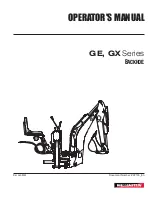
INTRODUCTION
Thank you for selecting the HRC-100-RS-HW Hydro-Rain
®
sensor. This sensor
will provide conservation, convenience, and flexibility to your fully automatic
watering system. Never again will you see your sprinklers running on a rainy
day. After a set amount of rain has fallen the sensor engages a switch that
will prevent the timer from watering. Once the rain sensor has dried
sufficiently or the temperature rises above 37˚F (3˚C), the sensor allows
normal sprinkler operation.
INSTALLATION INSTRUCTIONS
Mounting
The HRC-100-RS-HW sensor includes 2 mounting options.
1. ½" Threaded Adapter
2. Rain Gutter or flat surface adapter
Mount the sensor where it will be exposed to direct, unobstructed rainfall
(but away from sprinkler spray). The switch-housing portion must be upright
(see Figure 1).
Hints for mounting:
A. Mount as close as possible to the timer. This will cause the wire run to be
shorter, which minimizes the possibility of wire breaks.
B. Mount in the highest possible position where rain can fall directly upon the
sensor.
C. As described in the “Operation” section of this manual, “reset rate” refers to
the amount of time it takes the sensor to dry out sufficiently for the sprinkler
system to be allowed to come back on. The mounting location will affect this
rate and should be taken into consideration should extreme conditions exist.
For example, mounting the sensor on a very sunny, southeastern end of
a building may cause the sensor to dry out sooner than desired. Similarly,
mounting on the northern end of a building with constant shade may keep the
sensor from drying soon enough. Some experimentation and use of the “vent
ring” (as described later) will usually yield satisfactory results.
Once the sensor is mounted, run the wire to the controller, using wire clips
every few feet to fasten it. If an extension to the wire provided is needed, use the
following table to determine the minimum wire gauge needed:
Wiring
Important: The sensor is sold and designed for 24-Volt irrigation controllers
only. All wiring must conform to applicable local codes.
The two most common wiring situations are detailed below. For non-standard
wiring situations, please consult your distributor.
A. 24-Volt Solenoid Valves Only (No booster pump) (See Figure 2) With the two
wires from the sensor at the controller, locate the “common ground” wire
of the solenoid valves. If it is connected to the common terminal on the
controller disconnect it. Attach one wire of the sensor to the “common”
terminal (usually marked “COM”) on the controller. Attach the other wire of
the sensor to the common wire leading to the valves. Note: The common wire
to the valves does not have to be interrupted at the controller. The sensor
may be wired anywhere along the common wire line.
B. 24-Volt Solenoid Valves with booster pump (See Figure 3). Locate the
common wire to the solenoid valves and the common wire lead to the coil
of the relay that starts the pump. If these two wires are connected to the
“common” terminal on the controller, disconnect both of them. Twist these
two wires together along with one wire from the sensor and secure with a
wire nut. Attach the other wire of the sensor to the “common” terminal on the
controller.
Note: The pump circuit output must be 24 volts in this situation if
different do not proceed.
25-50 ft.
50-100 ft.
100 ft. or more
20 AWG
18 AWG
16 AWG
Extension needed:
then use:






















